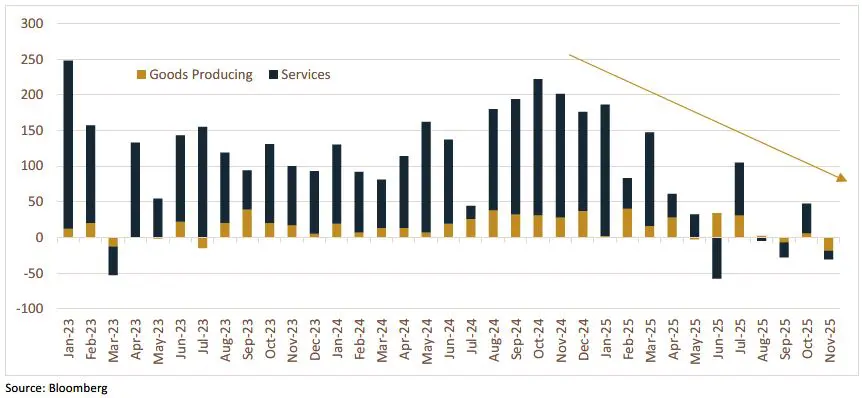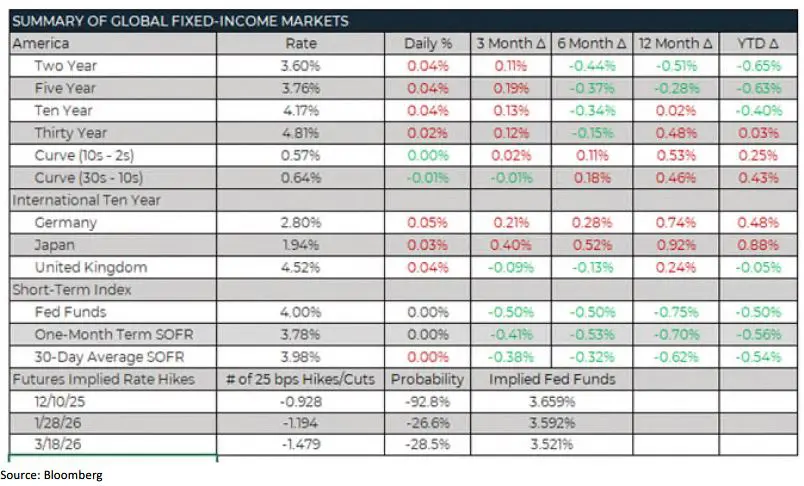We didn’t start the fire(ing) — Similar to a receding wave with an advancing tide, the labor market is providing mixed messages, seemingly getting worse and better concurrently. The great philosopher Billy Joel made a hit song in the late ‘80s denying claim to a myriad of global issues—and, no doubt, Joel would shirk responsibility for the current labor market if he rewrote that song today.
Last Wednesday’s weak ADP employment report highlighted the risks of a hastening deterioration in the labor market (Figure 1). The headline figure declined by 32,000 in November; companies with fewer than 50 employees shed 120,000 jobs, representing the largest one-month decline since May 2020. While small business struggled to keep jobs, large establishments with 50 or more employees increased headcount. Professional and business services led the decline in payrolls, followed by the information technology and manufacturing sectors. Hiring in education and health services increased. Charting the two main indices, one can tell that job gains have clearly slowed over the past year.

“Hiring has been choppy of late as employers weather cautious consumers and an uncertain macroeconomic environment,” Nela Richardson, chief economist at ADP, said in a statement. “And while November’s slowdown was broad-based, it was led by a pullback among small businesses.”
Separately, the Department of Labor released initial filings for unemployment benefits for the week ending November 29—filings declined by 27,000 to a total of 191,000 (Figure 2). The low print matched the last trough set in September 2022. California accounted for nearly half of the total drop in applications, followed by Texas and New York.

“Initial claims can be subject to big swings at this time of year, so we won’t read too much into one week’s number,” Nancy Vanden Houten, lead economist at Oxford Economics, said in a note. “Still, initial claims have remained in a range consistent with a relatively low pace of job losses despite recent layoff announcements.”
Separate data, released last Thursday by Challenger, Gray & Christmas, showed that announced layoffs at U.S. companies settled back in November after an October surge, but were still the highest for any November in three years (Figure 3). “Layoff plans fell last month, certainly a positive sign,” said Andy Challenger, the company’s chief revenue officer. However, the number was still up 24% from a year earlier and marked just the third time since 2008 that planned job cuts for November exceeded 70,000, he added. In addition to mounting layoff announcements, hiring intentions are down 35% this year compared to the same point in 2024. Year-to-date hiring plans are also the lowest since 2010. (That amount includes seasonal hires—and Challenger said there were no new holiday-hiring plans announced last month.)

The Federal Open Market Committee has now received all relevant labor market data heading into this week’s rate decision. “I think it’s still probably going to be a pretty divided decision,” said Veronica Clark, an economist at Citigroup. The expectation is that there will be a rate cut and that the forward guidance will be more hawkish, Clark said, as the Fed will also provide fresh quarterly economic projections after the meeting.
As we noted in a previous Talking Points, recent labor market reports contain something for everybody on the hawk/dove spectrum. Claims may be down. But as we learned during the government shutdown, private sources may be gaining more traction with market participants, and those sources are showing signs of weakness (witness last week’s reports from Challenger and ADP).
The other side of the Federal Reserve’s dual mandate remains somewhat benign. Friday’s delayed September inflation report left much to be desired. The core Personal Consumption Expenditures (PCE) Price Index— which excludes volatile food and energy—rose 0.2%, month over month, in September, in line with expectations and unchanged from August’s figure. Year over year, core PCE also matched expectations at 2.8% growth. Overall, the inflation data did little to move the needle in our market.
Related to the inflation story, according to the ADP report, workers who changed jobs in November saw a 6.3% increase in pay, the lowest since February 2021. Meanwhile, workers who stayed put saw only a 4.4% gain. In other words, not only are goods and services prices plateauing, so too are incomes—which reinforces the lack of inflationary impulse.
The takeaway here is the FOMC has plenty of data to depend on, but that information is not very clear. The hawkish members will point to the lack of inflationary pressures as reason to stand pat, while the doves will take aim at some of the weaker labor figures. What has yet to show up though, is a precipitous firing schedule from the broader labor market, which would be the tipping point for the doves to continue their easing cycle in earnest. Until then, we are likely to remain in this data dependency mode.
FROM THE DESK
Agency CMBS — The big news that hit our business last week was the Federal Housing Finance Agency’s announcement of the cap on multifamily purchase volumes for both Freddie Mac and Fannie Mae. The cap increased to $88 billion for each agency in calendar year 2026, reflecting a 20% increase from 2025. If both agencies hit their caps next year and Ginnie Mae also has strong issuance, agency CMBS issuance may hit a record high. Fannie Mae DUS new origination volume last week was $850 million, slightly lower than the week prior. Fannie investor spreads held in despite Treasury volatility: Spreads tightened last Monday, but remained steady as the week went on. Ginnie Mae spreads tightened by about six basis points from Monday to Friday. We expect that Ginnie Mae volume will remain light for the remainder of 2025 because HUD employees lost six weeks to process loan applications. It will now likely take about three weeks to ramp up production just in time for HUD employees to use their remaining days off during the holidays.
Municipals — AAA tax-exempt yields were relatively flat on the front end and higher on the long end of the yield curve, week over week. We saw a large new issuance calendar last week, with over $16 billion coming to market. The municipal bond market absorbed the volume well to start the month, as municipal bond inflows and $24 billion of December principal and interest receipts helped keep the market relatively steady. We expect the next two weeks to remain busy before new issue volume slows down for the holidays. Municipal bond funds had a second straight week of inflows, with $736 million entering (YTD inflows of $23.51 billion); high-yield funds collected $253 million of those inflows.



Looking for more economic insights? Check out all of our previous Trading Desk Talk posts.
The information contained herein, including any expression of opinion, has been obtained from, or is based upon, resources believed to be reliable, but is not guaranteed as to accuracy or completeness. This is not intended to be an offer to buy or sell or a solicitation of an offer to buy or sell securities, if any referred to herein. Lument Securities, LLC may from time to time have a position in one or more of any securities mentioned herein. Lument Securities, LLC or one of its affiliates may from time to time perform investment banking or other business for any company mentioned.
